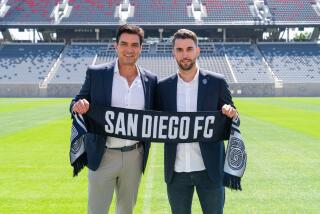L.A. vs. Moscow on Gridiron? Think About It : And Some People Are as 2 More Pro Leagues Are Being Proposed
People have been starting new football leagues, or threatening to do so, for most of this century.
Since 1919, the National Football League has been opposed by four or five American Football Leagues plus many others bearing such titles as All-American, World, and United States leagues.
And as recently as this week, there were two new developments in that old obsession:
In Chicago, Charlie O. Finley, the inventor of the designated hitter and the builder of three World Series champions with the Oakland A’s in the early 1970s, said he has dropped plans to merge nine Canadian Football League teams with nine from the United States.
“We haven’t abandoned the idea of a new fall league,” Finley said. “We just won’t be involved with the CFL.”
In New Orleans, meanwhile, David F. Dixon, the businessman who brought both the Saints and the Superdome to his town and who later launched the USFL, said he is ready to go with his new spring football league.
“We’re calling it the American Football Federation,” he said. “And we’ll be playing our first games in 11 months--starting Feb. 27. We’ll play a 20-week season, with no exhibition games, but with a best two-of-three (championship series). Two of the 12 AFF teams will be based in England.”
In Dixon’s view, the USFL demonstrated that there are enough talented players and willing fans for a spring league.
“It was leadership mistakes that killed the USFL,” Dixon said. “The argument over playing in the spring or fall destroyed their credibility. Before that, the USFL averaged TV ratings of 5.5 and 6. They averaged crowds of 20,000 and 25,000.
“Compared to the NFL, those figures are low. But compared to everything else, particularly everything on TV in the spring, they’re excellent. Sponsors are anxious for 5.5 programming in spring sports.”
Financially, Dixon holds that no new league can make it unless its club owners are restrained from bidding against the NFL for players, “which the USFL did in a misguided effort to force a merger.”
Dixon proposes two radical features.
Each owner will own a share of the league--instead of owning an individual club. And all costs will be controlled by the league office.
“Every owner will be autonomous,” Dixon said. “He can run his club any way he sees fit after his annual budget has been established (by the AFF). You won’t be able to buy an AFF champion. The best football guys will win it.”
He added that the first 12 franchises will be awarded free of charge to those putting up $2.5 million in each city for club operating expenses.
Dixon said he has had more than enough ownership applications--including three from Los Angeles.
He also said that the AFF will not immediately be a major league, although he expects it to be accepted as major when his younger players mature within five years.
Other proposals for Dixon’s league:
--Fifty-man rosters paid from a percentage of gross receipts, with players sharing 40% to 55% of the revenues on a minimum-salary, performance-bonus basis.
--Each owner will have a seat on the national board and an equal voice in league management.
--Assuming that there will be a television package, blackouts will be lifted when 50% to 60% of the seats have been sold.
--Franchises for major markets on the basis of natural rivalries: two in Texas, two in Florida, two in California, two in the East, New York and Boston; and two in the Midwest, Chicago and Detroit.
--The teams in England will be in London, in the south, and Manchester or Birmingham, or both, in the north. “Travel costs aren’t that much,” Dixon said. “And Los Angeles vs. London sounds very exciting.”
--Eventual expansion to many other U.S. and foreign areas, including Washington and Baltimore, Paris and Rome, two in Canada, “and, I hope, Moscow and Leningrad,” Dixon said.
--The first game of each year’s prime-time three-game championship series will be scheduled into the same stadium annually, probably the New Jersey Meadowlands. Subsequent scheduling will be in home-city stadiums.
--Primarily night games, with only one day game weekly. The season will be split, the first 10-game half extending from Feb. 27 to April 25, 1988, and the second from May 2 to June 27. The first playoff date is July 3.
--Cable TV, although network TV isn’t out. Dixon said that because of speedup measures, AFF games will usually end in 2 hours and 45 minutes and “will always fit in a three-hour package.”
--The possible signing of some top high school graduates, junior college players and college undergraduates, “primarily those who would have difficulty meeting the new NCAA academic standards.” Such players would get “intensive tutoring in season” plus four-year college scholarships at AFF expense.
--Possible stock ownership for fans and players.
--NFL rules, with selective changes. On pass receptions, for example, the college rule--one foot in bounds--is planned.
--Emphasis on injury reduction, with knee braces mandatory.
--A chief executive officer instead of a commissioner, with Dixon serving as chairman to enforce the original budgetary concept.
“Let me comment on two things that everyone asks about,” Dixon said.
“First, Los Angeles is the one market we want to be in. It’s the richest market in the world. Sports teams that are properly operated in L.A.--the Dodgers, the Lakers, the Raiders--are the best franchises there are.
“Second, spring is the best time for football. The game has been played in the fall simply because the first game was in the fall. That was a historical accident.”
More to Read
Go beyond the scoreboard
Get the latest on L.A.'s teams in the daily Sports Report newsletter.
You may occasionally receive promotional content from the Los Angeles Times.










